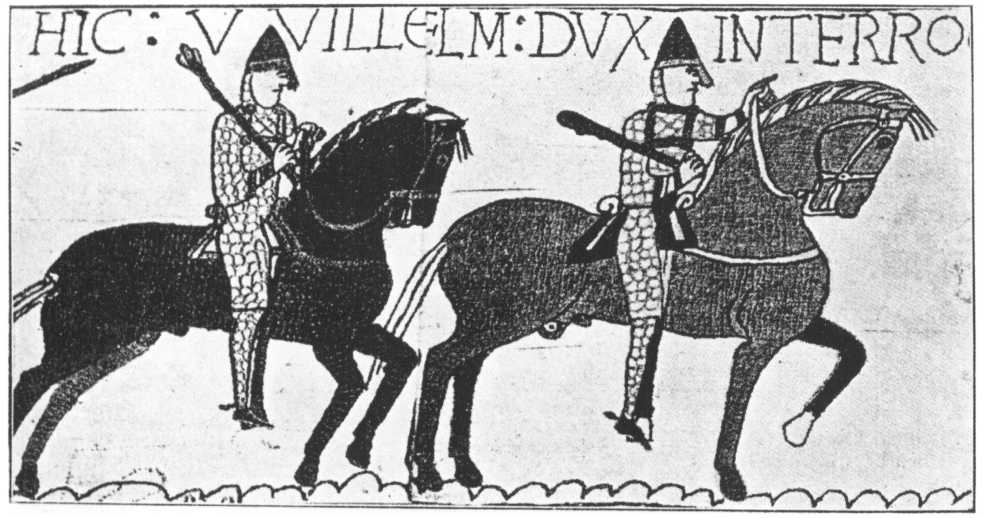m856

Two Normans (named as William and an attendant) from the Bayeux tapestry; they are armed with an iron-headed mace and a club.
trates the infantry using their spears to provide a thicket of points against cavalry, as they would surely have done to make the charging horses refuse.
For this cavalry the spears retained their normal role; the throwing spear for hurling at an enemy from close rangę in an attempt to create a gap in the shield wali, and the thrusting spear, used either overarm or underarm, to probe for weak spots in a man’s delences during individual combat. For example, Hugh fitz Giroie was mortally wounded during a training exercise before the conąuest by a llance’ carelessly thrown by his armiger (esąuire). In the Baycux tapestry, spears, or lances if you prefer, are shown being brandished: some of these may have been thrown, but an overarm thrust would also be the most effective way for a mounted man to get a strike past a shield.
The Norman shield was perhaps their most characteristic piece of eąuipment: the well-known kite-shaped shield which covered a man, whether on foot or horseback, from the shoulder to the shin. On horseback the unique shape enabled the shield to cover the undefended side down to the ankle, and was slung round the neck by a strap called the guige. For combat the left arm was placed through two vertical straps (enarmes) on the back of the shield, the left hand grasping the reins.
Axes were used to a limited extent, but these were short-handled weapons, used on horseback with one hand, in place of a sword.
The bow was known as the ‘Danish’ bow, that is similar to that employed by the Vikings. Although comparatively ineffective against troops with shields, it could penetrate a hauberk and kiII the wearer at ranges of up to 46111, and with a trajectory arrows could be sent some 92111. Archery was much promotcd by Charlemagne, but its use in warfare by the Franks declined after his death; William appears to havc fostered the arm and developcd a considerablc body of archers, whose value he fully appreciated. The Normans were to continue to exploit archery in warfare in Fmgland, of course. Quivers were mostly worn at the waist bel t.
The mail shirt was ol the normal interlinked ring construction, with alternate rows rivetted and butted, but in the iith century its length was increased to reach to the knees or even the calves, and it was slit at front and rear from hem to crotch to enable the wearer to ride a horse. It would appear to have been of a morę robust construction than that of the Saxons and Vikings. The wide sleevcs still reached only to the elbows, although by 1066 a lew of the nobles wore mail sleeves which reached to the wrist under the hauberk.
Wyszukiwarka
Podobne podstrony:
m854 Wiiliam’s siege of Dinant, as shown in the Bayeux tapestry. The Normans on the left are obvious
Using Replication for Backups To use replication as a backup solution, replicate data from the maste
Slide3 RECOGNISE IT See the information from side two of your cards (Polish) and think or say the&nb
scan0029 (2) Yolume 34/Number U/November 1997 result of weathering, such as evaporation and degrada-
The Illustrated History of Ammunition TUK ILI-UST RAT KI) IIISTORYAMMUNITION l.X V IKX« Miliwn and c
I/ Enough yr? and enough indicate degree. They are used with adjectives v means morę than what is
149 Vol. 36(2), 2001 70% ethanol, and were extracted from the shells by decalcif^ation in Railliet-H
From File blok Błock Parameters: Fiom File From File Read tirne and output values from the first mat
11 acąuisition and resulted directly from the necessity to enter the water for oviposition. The sepa
więcej podobnych podstron